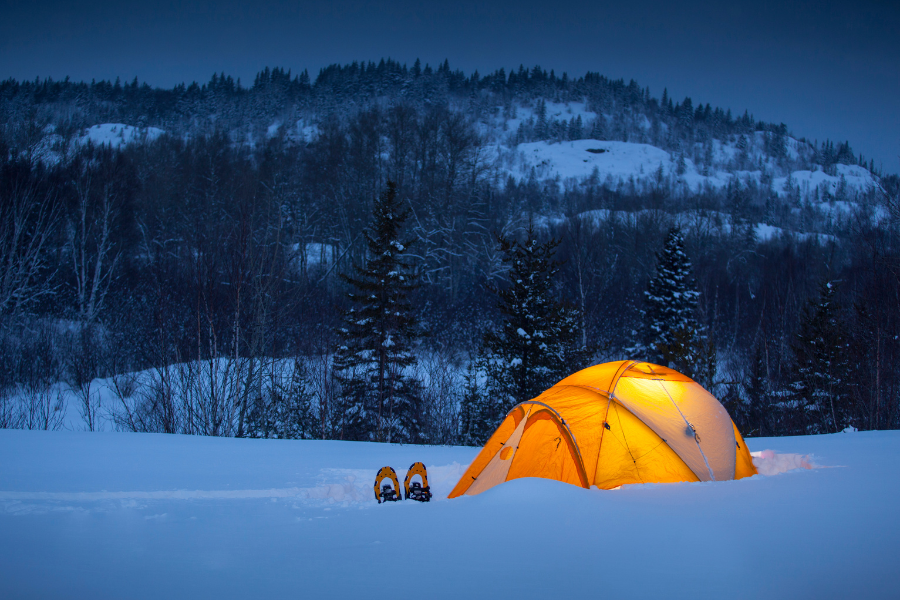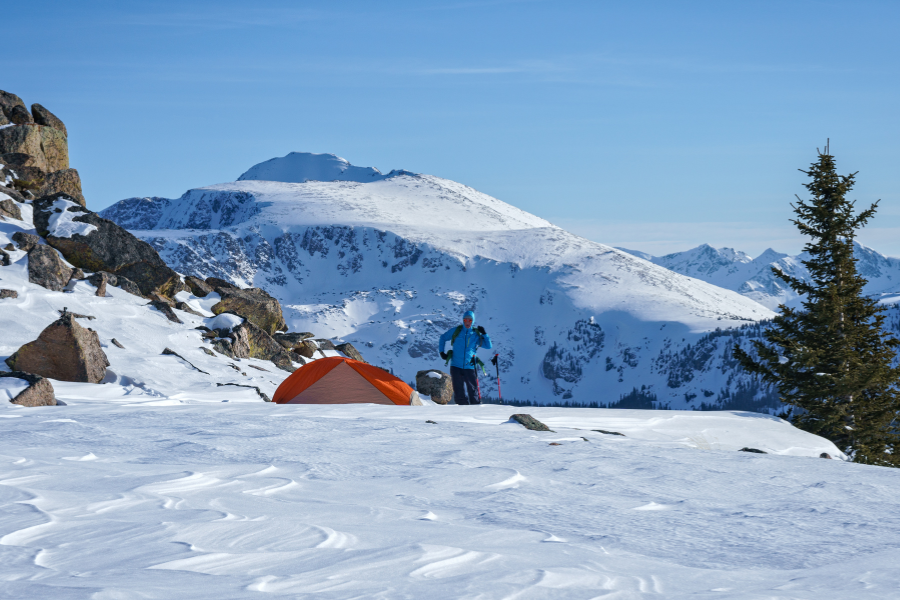Stay Warm and Cozy: 10 Winter Camping Hacks
Winter Camping can be a thrilling and adventurous experience.
However, it also comes with its own set of challenges, especially when it comes to staying warm in your tent.
In this article, we will provide you with some valuable cold camping tips to help you stay cozy and comfortable during your tent camping adventures, including winter camping.
We will cover winter camping gear and other tips and tricks, from choosing the right tent to the importance of staying dry and eating high-calorie foods.
So, whether you’re a seasoned camper or a beginner, these winter camping tips will help you create the best experience.
1. Choose the Right Tent
The first step to staying warm in your tent is to choose the right one. Look for a tent that is specifically designed for winter camping. These tents are usually made with thicker and more insulating materials, which can help retain heat inside.
Considerations When Choosing a Tent
When choosing a tent for cold weather camping, there are several factors to consider.
Firstly, the material of the tent is important. Look for tents made from materials like polyester or nylon, which are known for their insulating properties.
Secondly, the size of the tent matters. A smaller tent will be easier to heat up, but make sure it’s still big enough to comfortably accommodate you and your camping gear.
Finally, consider a winter camping tent, sometimes referred to as a four-season tent. They are specifically designed for winter camping and can withstand harsh weather conditions.
You might consider a canvas tent which has more space and can manage heavy snow loads. However, investing in a tent stove or wood-burning stove will help heat this larger tent size and can elevate your winter camping experience.

2. Insulate Your Tent
Ground Insulation
Even with a cold-weather tent, it’s important to take extra steps to insulate your tent further.
Start by placing a groundsheet or tarp underneath your tent to provide an extra layer of insulation from the cold ground. This will help prevent the cold from seeping up through the floor of your tent.
Interior Insulation
You can also use rugs or blankets inside the tent to cover the floor and create a barrier between you and the cold surface. This will not only add an extra layer of insulation but also make the tent feel more homely and comfortable. You can also hang blankets or tarps from the walls of the tent for added insulation.
Also, the difference in the temperature on the inside to the outside creates humidity. Staying dry in your tent is crucial when camping in cold weather. Moisture can lower your body temperature and make you feel colder than you actually are.
To prevent this, make sure to dry off before entering your tent and avoid hanging wet clothes or gear inside. If possible, invest in a waterproof tent or add a rainfly to keep the moisture out.
DIY Insulation
- Use blankets or sleeping bags to cover the tent walls for added insulation.
- Place a rug or foam mats on the tent floor to provide insulation against the cold ground.
- Hang a thermal curtain or tarp over the tent entrance to create an airlock.
3. Use a Good Quality Sleeping Bag
Investing in a good quality sleeping bag is crucial for staying warm during cold camping trips. Look for a sleeping bag that is specifically designed for cold weather conditions and has a temperature rating suitable for the temperatures you expect to encounter.
Using a Sleeping Bag Liner
Additionally, consider using a sleeping bag liner for added insulation and warmth. A liner can add several degrees of warmth to your sleeping bag and can also keep it clean and prolong its lifespan.
4. Layer Up
Layering your clothing is essential for staying warm in cold weather.
Start with a moisture-wicking base layer to keep sweat away from your body. Add an insulating layer, such as a fleece or down jacket. Finally, top it off with a waterproof and windproof outer layer to protect you from the elements.
Layering Your Extremities
Don’t forget to layer your socks and wear a winter hat to keep your extremities warm. Your feet and head are areas where heat loss can occur rapidly, so it’s important to keep them well insulated. Consider wearing thermal socks and a woolen hat for maximum warmth.

5. Stay Dry
Staying dry is crucial for staying warm in cold weather. Moisture, whether from sweat or external sources, can quickly make you feel cold and uncomfortable. Make sure to pack moisture-wicking clothing and avoid cotton, as it retains moisture.
What to Do If You Get Wet
If you do get wet, change into dry clothes as soon as possible to prevent hypothermia. It’s a good idea to pack extra clothes in a waterproof bag for this purpose. Also, try to dry out any wet gear as soon as you can to prevent it from making you cold later on.
6. Use Hot Water Bottles
Staying warm at night when you aren’t active can be tricky. I personally hate wearing my heavy down jacket inside my sleeping bag. It feels too claustrophobic and I feel extra cold when I finally emerge from my winter sleeping bag.
Hot water bottles are a simple yet effective way to add warmth to your sleeping bag to maintain body heat and stay warm through the night.
Fill a non-insulated water bottle with almost boiling water before bed and place it at the foot of your winter sleeping bag to maintain your body temperature. The heat from the bottle will radiate throughout the night, keeping you warm and cozy.
How to Use a Hot Water Bottle Safely
When using hot water bottles, it’s important to ensure they are securely sealed to prevent leaks.
Also, wrap them in a towel or cloth to prevent direct contact with your skin, which could cause burns.
Remember to refill them with hot water before you go to bed each night. If you are camping in winter and there is snow, melt snow to boiling point so you are not wasting your clean water.
I personally then drink the water the next day. Sometimes it is still warm and drinking the warm liquid helps the manage the shock of the cold in the early morning.
Heat Packs
- Use disposable heat packs to warm up your hands, feet, or any other cold body parts.
- Place the heat packs inside your sleeping bag or pockets for continuous warmth.
7. Eat High-Calorie Foods
Eating high-calorie foods can help keep your body warm by providing it with the energy it needs to generate heat. Pack foods that are rich in carbohydrates and healthy fats, such as nuts, granola bars, and dried fruits.
Warm Beverages
Additionally, drink warm beverages like hot chocolate or herbal tea to warm up from the inside. Not only do these drinks help to warm you up, but they also help to keep you hydrated, which is crucial in cold temperatures.

8. Sleeping Pads
A sleeping pad is not just for comfort, it also provides insulation from the cold ground.
A good quality sleeping pad can add an extra layer of warmth and prevent heat loss through conduction.
Types of Sleeping Pads
- Closed-cell foam pads: These are lightweight, durable, and provide good insulation but may not be as comfortable as other options.
- Inflatable pads: These are more lightweight and comfortable, but can be punctured easily. Make sure to bring a repair kit with you just in case.
- Self-inflating pads: These combine the benefits of both closed-cell foam and inflatable pads, providing good insulation and comfort. They are my choice every time, however, they are pricier than other options.
Insulating Your Sleeping Pad
To further increase the insulation of your sleeping pad, you can place a reflective emergency blanket underneath it. This will reflect your body heat back towards you, providing additional warmth.
9. Use a Tent Heater
If you’re camping in extremely cold conditions, consider using a tent heater. There are various types of tent heaters available, including propane heaters and electric heaters.
If you choose a canvas tent, choose one that you can fit a stove tent. These wood-burning stoves are great for winter conditions to help you maintain body temperature and keep you toasty for 24 hours.
Safety Precautions
However, it’s important to use them with caution and follow the manufacturer’s instructions to prevent accidents or carbon monoxide poisoning.
Always ensure there is adequate ventilation when using a heater and never leave it unattended.
10. Keep Your Tent Ventilated
While it may seem counterintuitive, keeping your tent properly ventilated is essential for staying warm. Proper ventilation helps prevent condensation from building up inside the tent, which can make you feel damp and cold.
Additionally, as above, you will need to take specific care when using a Tent Heater or Stove.
How to Ventilate Your Tent
Open a small vent or crack a window to allow fresh air to circulate while still retaining heat.
Be careful not to overdo it, though, as too much ventilation can let out too much heat. It’s all about finding the right balance.

Conclusion
A winter camping trip can be a rewarding experience, but it’s important to take the necessary precautions to stay warm and comfortable.
By choosing the right tent, insulating your tent, using a good quality sleeping bag, layering up, staying dry, using hot water bottles, eating high-calorie foods, staying active, using a tent heater (if necessary), and keeping your tent ventilated, you can ensure a cozy and enjoyable cold weather camping trip.
So, pack your gear, follow these tips, and embrace the beauty of winter camping!
Remember, preparation is key, and with the right gear and knowledge, you can make your cold-weather camping experience a memorable one.





Comments are closed.